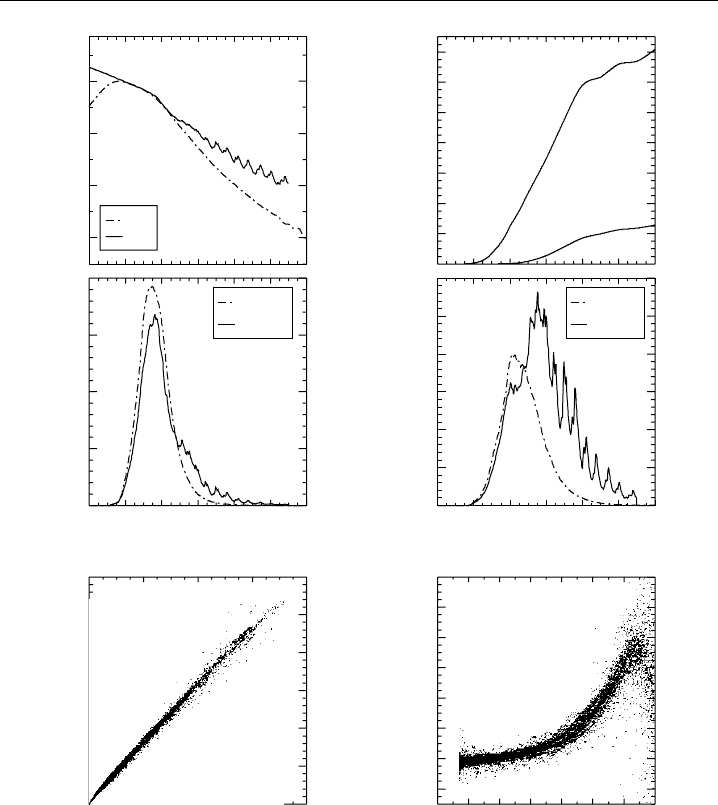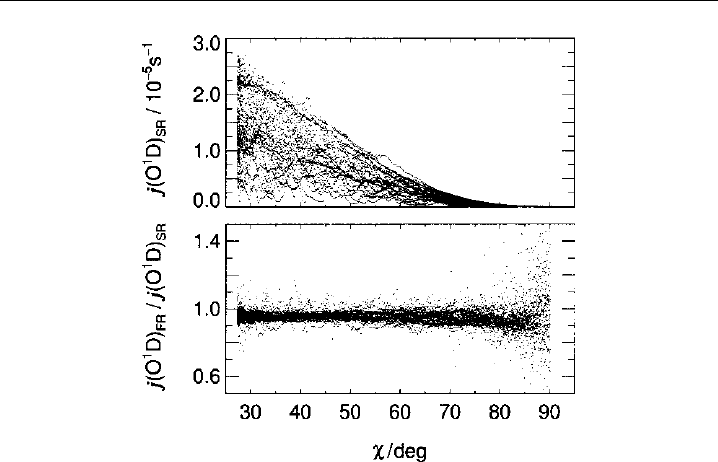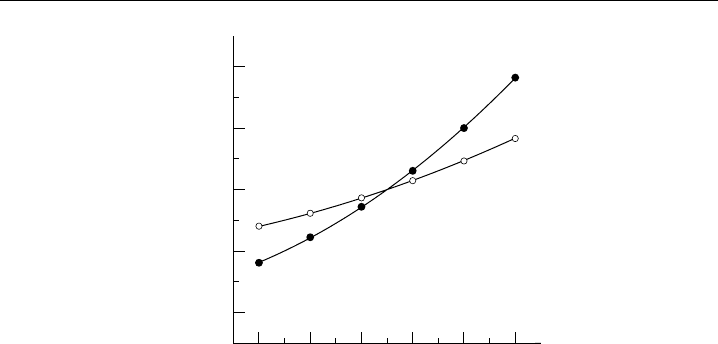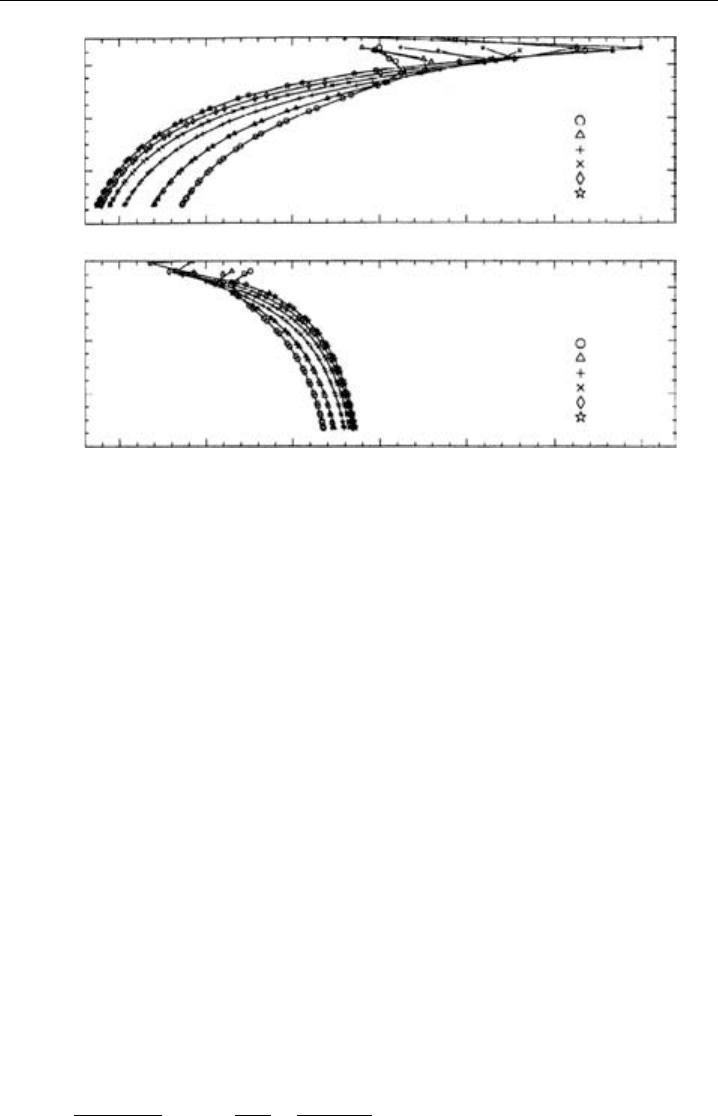Heard D.E. (editor) Analytical Techniques for Atmospheric Measurement
Подождите немного. Документ загружается.


458 Analytical Techniques for Atmospheric Measurement
9.5.3 Filter radiometer calibration
The determination of the quantities A
0
and f needed for the evaluation of Equation 9.50
is a laborious task which requires:
•
the measurement of the instrumental response functions, Z
p
and D
rel
,
•
an absolute calibration of A
0
or D
abs
,
•
knowledge of the molecular parameters and , and
•
a set of modelled actinic-flux spectra for different solar zenith angles and, where
necessary, for a range of values of other atmospheric parameters.
9.5.3.1 Instrumental characteristics
The instrumental characteristics Z
p
, D
rel
, and D
abs
can be obtained from laboratory
measurements. The angular-response correction of a filter radiometer can be determined
in a similar way as in the case of a spectroradiometer. The Z
p
values are measured by
rotating a lamp with broadband emission over the field-of-view of the receiver. The
angular-correction factor Z
H
is then derived from the measured Z
p
values as outlined in
Appendix A.4, using a model for the angular distribution of the atmospheric radiance.
See Sections 9.4.3 and 9.4.5 for further details.
The spectral response function D
rel
can be either estimated from the specified
wavelength-dependencies of the filter transmission and the detector sensitivity, or
measured preferably for the complete radiometer using a tunable narrow-bandwidth light
source. The tunable light source can be realised, for example, by a combination of a
broadband Xe-arc lamp and a scanning monochromator, which is calibrated against a
reference photodetector having a known spectral sensitivity (Bohn et al., 2004).
When required, D
abs
can be measured by exposing the filter instrument to the radiation
of a calibration lamp. The lamp is positioned relative to the inlet optic of the radiometer
as described for an actinic-flux spectroradiometer (Section 9.4.5). A value for D
abs
is
then obtained by measuring the radiometer signal U
cal
when the instrument receives the
specified irradiance E
(Bohn et al., 2004):
D
abs
=
U
cal
D
rel
E
d
(9.51)
9.5.3.2 Instrumental correction function
The factor f needed for the correction of the filter radiometer data can be determined
from Equation 9.48 as:
f t
O
3
TT
R
h=
A t
O
3
TT
R
h
A
0
(9.52)
When A is replaced by Equation 9.46, f can be represented by the product of four factors:
f t
O
3
TT
R
h=f
1
f
2
f
3
f
4
(9.53)

Measurement of Photolysis Frequencies in the Atmosphere 459
where
f
1
=
Z
H
0
Z
H
(9.54)
f
2
T
R
=
D
abs
T
0
R
D
abs
T
R
(9.55)
f
3
T t
O
3
h=
T T F
d
T
0
T
0
F
0
d
(9.56)
f
4
T
R
t
O
3
h=
D
rel
T
0
R
F
0
d
D
rel
T
R
F
d
(9.57)
with F
= F
t
O
3
h and F
0
= F
0
t
0
O
3
h
0
Here, f
1
represents the relative influence of the solar zenith angle on the angular-
response correction; f
2
describes the relative dependence of the absolute detector sensi-
tivity on the radiometer temperature; f
3
considers the influence of the air temperature
and ambient parameters t
O
3
hon the spectral overlap between × and F
;
and, similarly, f
4
considers the influence of the radiometer temperature and the ambient
parameters on the spectral overlap between D
rel
and F
.
In order to calculate the factors f
i
i = 1 2 3 4, values for all relevant quantities on
the right sides of Equations 9.54–9.57 must be available. Values of and may be
taken from the literature (see Section 9.8.4), whereas the behaviour of Z
H
, D
rel
and
D
abs
must be derived from laboratory measurements (see p. 458). Furthermore, a set of
solar actinic-flux spectra simulated by a radiative transfer model for different ambient
conditions is required for the determination of f
3
and f
4
. Examples of f
i
factors for jO
1
D
and jNO
2
filter radiometers will be given in Sections 9.5.4 and 9.5.5.
9.5.3.3 Absolute calibration
Filter radiometers can be calibrated absolutely in two possible ways: either by a direct field
comparison versus another absolute measurement technique, or radiometrically against
the intensity of a calibration lamp in the laboratory.
In the first approach, the filter radiometer is operated side-by-side with a reference
instrument (e.g. a chemical actinometer) that delivers absolute photolysis frequencies. The
calibration factor A
0
is then directly obtained from a linear regression of the measured
j-values plotted versus the product U ×fp
i
, where U is the filter-radiometer signal
and fp
i
the correction factor for the ambient conditions during the calibration (cf.
Equation 9.50).
In the second approach, A
0
is determined from the quantities obtained in the laboratory
D
abs
Z
H
D
rel
and the actinic-flux spectrum simulated for the selected standard condi-
tions (cf. Equation 9.46):
A
0
=
1
D
abs
T
0
R
Z
H
0
T
0
T
0
F
0
d
D
rel
T
0
R
F
0
d
(9.58)

460 Analytical Techniques for Atmospheric Measurement
This approach was applied for a jO
1
D filter radiometer (Bohn et al., 2004) and gave
good agreement in a field comparison against chemical actinometry and spectrora-
diometry (Hofzumahaus et al., 2004). The most convenient calibration method for filter
radiometers, however, remains the direct field comparison against calibrated reference
instruments.
9.5.4 jO
1
D filter radiometers
The photolysis of ozone leading to the formation of O
1
D atoms occurs predominantly
at wavelengths below 320 nm. In this wavelength region, the solar radiation has a spectral
distribution that is strongly dependent on the solar zenith angle and total atmospheric
ozone. These two parameters have a strong influence on the calibration of a jO
1
D
filter radiometer, even if the spectral mismatch between D
rel
and × is small. Since
the photodissociation of O
3
is strongly temperature dependent, it is even in principle
not possible to match × exactly with a single filter–detector combination for all
conditions. Thus, a significant dependence on the parameters , t
O
3
and T exists for the
calibration of a jO
1
D filter radiometer.
The effect of an imperfect spectral match is demonstrated in Figure 9.29 for a filter
radiometer operated at ground (Bohn et al., 2004). Panel (a) reproduces the data from
Figure 9.27 on a logarithmic scale, revealing a significant difference in the spectral
progression of D
rel
and × at long wavelengths > 315 nm. The difference is more
strongly weighted by the solar spectrum when the zenith angle is high, leading to a
substantially different dependence of jO
1
D and U on (see panels (b, c, d)). This
behaviour was studied by corresponding field measurements of jO
1
D and U . Although
the two quantities appear to be well linearly correlated (panel (e)), a closer look reveals
a significant change of their ratio by a factor 2, when varies from 30
to 80
(panel
(f)) (Bohn et al., 2004). Similar variations of jO
1
D/U were found for other jO
1
D
filter radiometers (Junkermann et al., 1989; Hofzumahaus et al., 1992; Shetter et al.,
1996; Brauers et al., 1998). The functional dependence on , however, looked different
for each instrument, because the spectral characteristics of the transmission filters and
photosensors were not exactly the same.
In order to understand the variability of A = jO
1
D/U for a specific filter radiometer,
the correction function f = f
1
f
2
f
3
f
4
must be determined as discussed in the previous
section. For an instrument operated at ground, the factor f
1
has usually a value near
unity f
1
≈ 1, because Z
H
exhibits only a weak dependence on in the UV-B spectral
region in the lower troposphere (Hofzumahaus et al., 1999). The factor f
2
is also essen-
tially unity, since jO
1
D filter radiometers are normally temperature stabilised to avoid
unwanted wavelength shifts of the interference-filter transmission curve. The stabili-
sation also prevents temperature drifts of the photomultiplier sensitivity. Thus, only the
correction factors f
3
and f
4
remain to be considered with respect to variations of the air
temperature, solar zenith angle and total ozone:
f t
O
3
T≈ f
3
t
O
3
Tf
4
t
O
3
(9.59)

Measurement of Photolysis Frequencies in the Atmosphere 461
10
–6
10
–4
10
–2
1
D
rel
σφ / 3.8·10
–19
cm
2
D
rel
σφ
0.0
0.2
0.4
0.6
0.8
1.0
1.2
1.4
290 300 310 320 330 340 350
λ /nm
0.0
0.5
1.0
1.5
2.0
D
rel
F
λ
/
2·10
12
cm
–2
s
–1
nm
–1
D
rel
F
λ
/2·10
10
cm
–2
s
–1
nm
–1
σφ F
λ
/10
–6
s
–1
nm
–1
σφ F
λ
/ 10
–8
s
–1
nm
–1
D
rel
F
λ
σφ F
λ
D
rel
F
λ
σφ F
λ
290 300 310 320 330 340 350
λ /nm
0.0
0.5
1.0
1.5
2.0
2.5
3.0
χ = 30°
χ = 30°
χ = 80°
χ = 80°
(a) (b)
(d)
(c)
(e)
01234
U/
V
0.0
0.5
1.0
1.5
2.0
2.5
3.0
20 30 40 50 60 70 80 90
χ
/degree
0.6
0.8
1.0
1.2
1.4
1.6
1.8
2.0
F
λ
/10
14
cm
–2
s
–1
nm
–1
j (O
1
D)
SR
/10
–5
s
–1
j (O
1
D)
SR
/U
/
10
–5
s
–1
v
–1
(f)
Figure 9.29 Demonstration of the effects caused by an imperfect matching between D
rel
and for
a jO
1
D filter radiometer. (a) Wavelength dependence of D
rel
and plotted on a logarithmic scale
(data from Figure 9.27). (b) Simulated actinic-flux spectra at two different solar zenith angles = 30
and = 80
at a total ozone column t
O
3
= 360 DU. (c), (d) Spectral distributions of D
rel
F
and F
at
=30
and =80
, using the data from panels (a) and (b). (e) Correlation of jO
1
D field data measured
by a spectroradiometer with the simultaneously recorded filter-radiometer signal U. (f) Ratio of jO
1
D
and U as a function of , using the data from panel (e) (from Bohn et al., 2004).

462 Analytical Techniques for Atmospheric Measurement
The relative temperature dependence of the photodissociation of O
3
is of general
interest and can be described separately by the factor b:
b =
jO
1
D t
O
3
T
jO
1
D t
O
3
T
0
(9.60)
Thus jO
1
D can be calculated from the measured voltage U by:
jO
1
D = A
0
f t
O
3
T
0
b t
O
3
TU (9.61)
Figure 9.30 shows as an example f t
O
3
T
0
values that apply to the spectral
radiometer sensitivity shown in Figure 9.29(a). Here f was determined from measured
instrumental parameters and modelled actinic-flux spectra for different solar zenith
angles = 0
–87
, ozone columns t
O
3
=240–460 DU, and a constant air temperature
T
0
= 295K (Bohn et al., 2004). Figure 9.31 demonstrates that the application of these
f values yields good agreement of filter radiometer–derived jO
1
D values with measure-
ments by a spectroradiometer over a broad range of zenith angles and a highly variable
cloud cover. Note that in this example A
0
was absolutely calibrated against a certified
irradiance standard using Equations 9.51 and 9.58.
It should be noted that the discussion of jO
1
D filter radiometers in this section refers
to a ground-based operation only. If the instruments are deployed on an aircraft, the
correction factors f and b need to be evaluated for the altitude at which measurements
0 20 40 60 80
χ
/degree
0.5
1.0
1.5
2.0
2.5
f (χ, t
O
3
)
440 DU
340 DU
240 DU
Figure 9.30 Example of correction factors f t
O
3
T
0
(solid circles) that apply to the spectral filter-
radiometer sensitivity shown in Figure 9.29(a). The data refer to an air temperature T
0
=295 K and ground
level, and are normalised to the reference conditions t
O
3
= 350DU and = 30
. The full lines show a
parametrisation of the data points (from Bohn et al., 2004).

Measurement of Photolysis Frequencies in the Atmosphere 463
Figure 9.31 Upper panel: Dependence of jO
1
D on the solar zenith angle, measured by an actinic-flux
spectroradiometer (SR) in Jülich, Germany, from 10 to 27 June, 1997. The strong variability of jO
1
D
at given zenith angles is mainly caused by clouds and to some extent by total ozone (315–380 DU).
Lower panel: Ratios of simultaneous jO
1
D measurements obtained from a filter radiometer (FR) and
actinic-flux spectroradiometer (upper panel). For both data sets an air temperature of 295 K was assumed
(adapted from Bohn et al., 2004).
are performed, requiring an assumption on the partitioning of the total ozone column
above and below the measurement altitude.
9.5.4.1 jO
1
D temperature dependence
The relative dependence of jO
1
D on the air temperature, represented by the factor
b (Equation 9.60), was calculated and parameterised for sea level conditions by Bohn
et al. (2004) from published ozone absorption cross-sections (Malicet et al., 1995),
O
1
D quantum yields (Talukdar et al., 1998), and simulated actinic-flux spectra for a
range of solar zenith angles = 0
–87
, total ozone columns t
O
3
= 240–460DU, and
temperatures (270–320 K). Figure 9.32 shows two examples of b as a function of T for
the maximum and minimum values of total ozone and solar zenith angles covered by the
simulated spectra. The two curves represent the minimum and maximum temperature
dependence of jO
1
D within the limit of these conditions and correspond to temperature
sensitivities in the order of 05–1% K
−1
. The parametrisation of b and its numerical
coefficients can be found in the work of Bohn et al. (2004).
9.5.4.2 Accuracy
The accuracy of jO
1
D derived from filter radiometer measurements is determined by
the errors of the factors A
0
f and b entering Equation 9.61. The error of A
0
is mainly

464 Analytical Techniques for Atmospheric Measurement
270 280 290 300 310 320
T/K
0.6
0.8
1.0
1.2
1.4
b (T )
Figure 9.32 Relative temperature dependence b = jO
1
DT/jO
1
D295 K at the lowest and highest
ozone columns considered, combined with low and high zenith angles, respectively, marking the weakest
and strongest dependence within the ranges covered. Open symbols: t
O
3
= 240DU = 0
; closed
symbols: t
O
3
=460 DU =85
. The solid lines are parameterisations of the modelled data points (from
Bohn et al., 2004).
caused by the reference technique against which A
0
is calibrated. Possible reference
techniques are chemical actinometry (see Section 9.3.4), double monochromator–based
spectroradiometry (see Section 9.4.6), or calibration against a certified irradiance standard
(see Bohn et al., 2004). In all cases the total uncertainty is quite similar and lies typically
in the range of 10–15%. An additional error is contributed by the factors f and b,
which correct for non-linearities of the filter-radiometer calibration. If the corrections
are ignored and set to unity, errors can be as high as a factor of 2. If the correction
factors are applied correctly, remaining uncertainties in the range of 4% at <70
and
10% at 70
≤ ≤85
are possible (Bohn et al., 2004) and add to the total error.
9.5.5 jNO
2
filter radiometers
The evaluation of filter-radiometer data for jNO
2
is less complicated than for jO
1
D.
Unlike for O
3
, the photolysis of NO
2
depends only weakly on temperature and is
dominated by radiation that is not influenced by the total ozone column. In the
relevant wavelength range, the variation of the spectral actinic-flux distribution is mainly
controlled by the solar zenith angle, but the effect is much weaker than in the UV-B
region. Therefore, the spectral mismatch of the radiometer sensitivity to the photodis-
sociation spectrum of NO
2
has a relative small effect on the radiometer calibration.
The influence is typically less than 10% and depends mainly on the solar zenith angle
(Volz-Thomas et al., 1996).
Figure 9.33 shows as an example the function f that is required to correct for the
influence of the spectral mismatch at clear-sky conditions. The correction is plotted for
the filter combinations A and D from Figure 9.28 as a function of the solar zenith angle,

Measurement of Photolysis Frequencies in the Atmosphere 465
f(χ)
80
60
40
20
80
60
40
20
zenith angle (°)
zenith angle (°)
0.90 0.95 1.00
D
= (2 mm UG3, 1 mm UG5)
A = (1 mm WG305, 1 mm UG11)
1.05 1.10 1.15 1.20
0
km
1
km
3
km
5
km
7
km
9
km
0 km
1
km
3
km
5
km
7
km
9
km
0.90 0.95 1.00 1.05 1.10 1.15 1.20
Figure 9.33 Correction factors f as a function of the solar zenith angle at different altitudes for the filter
combinations A and D from Figure 9.28. The calculations assume clear-sky conditions (adapted from
Volz-Thomas et al., 1996, printed with permission from American Geophysical Union).
and for airborne applications at different altitudes in the troposphere. The correction
factors for the preferred filter combination D vary by 6% at ground and by 12% at 9 km
altitude when the zenith angle changes between 25
and 90
. The corresponding altitude
dependence is small and generally less than 5% at a given zenith angle.
It should be noted that the blocking of direct sunlight by clouds has a relative large
influence (3–5%) on the f values of a jNO
2
radiometer (Volz-Thomas et al., 1996).
The reason is that a relative large fraction of direct radiation (up to 50%) contributes
to jNO
2
and has a significantly different spectral composition compared to diffuse
radiation. Since it is impractical to correct routinely for such cloud effects, the influence
of clouds contributes to the overall uncertainty of the jNO
2
values.
Temperature has an additional, but small, influence on the jNO
2
filter-radiometer
calibration. In a laboratory experiment, the radiometer sensitivity was found to increase
by 2.5% when the temperature was lowered from 298 to 233 K (Volz-Thomas et al., 1996).
For most ground-based applications, where temperature variations are much smaller, this
effect can be neglected.
Temperature has also a weak influence on the photodissociation of NO
2
. This depen-
dence was studied experimentally with chemical actinometers in the laboratory (Dickerson
et al., 1982) and in field experiments (Shetter et al., 1988), giving very similar results in
both studies. Accordingly, the relative temperature dependence in the range of 227–400K
can be described as
b =
jNO
2
T
jNO
2
T
0
= exp
58 K
T
0
−
58 ±6K
T
(9.62)

466 Analytical Techniques for Atmospheric Measurement
(Volz-Thomas et al., 1996), corresponding to a sensitivity of about 0064% K
−1
at room
temperature.
In summary, jNO
2
values can be derived from measured radiometer voltages U by
the following expression
jNO
2
= A
0
f T
R
T
0
hbTU (9.63)
where the calibration corrections include dependencies on the solar zenith angle,
radiometer temperature, air temperature, and for airborne applications also altitude.
9.5.5.1 Accuracy
The accuracy of jNO
2
derived from filter-radiometer measurements is determined by
the errors of the factors A
0
f and b entering Equation 9.63. The calibration constant
A
0
can be derived from field comparisons with chemical actinometers or actinic-flux
spectroradiometers. The uncertainty of the chemical actinometer used as a calibration
reference for the commercially available filter radiometers is 5–7% (Volz-Thomas et al.,
1996; Kraus & Hofzumahaus, 1998), whereas spectroradiometry as a reference has an
uncertainty of about 12% (see Section 9.4.6). The uncertainty caused by the correction
factors for clear-sky conditions is 2.5% at <75
and 6.5% at >75
, whereas it is
about 5–7% for cloudy conditions (Volz-Thomas et al., 1996).
9.6 Irradiance radiometry
Most observational information about solar UV radiation reaching the earth’s surface has
been obtained from ground-based radiometers that measure irradiances. Measurements
are being performed since decades at different places worldwide, in order to investigate
the temporal and spatial variability of solar UV and its potentially harmful impact
on biological systems and the environment (see e.g. Urbach, 1969; Zerefos & Bais,
1995, and references therein). The discovery of the stratospheric ozone depletion in
the 1980s has been a strong motivation for measuring possible changes in surface UV
exposure. Thus, UV-monitoring networks have been established that are providing long-
term measurements, for example, via the World Ozone and Ultraviolet Radiation Data
Centre (WOUDC) or the European Ultraviolet Database (EUVDB) (Kerr et al., 2002).
Besides UV monitoring, irradiance radiometers have been used also for the determi-
nation of photolysis frequencies in the atmosphere since the late 1970s, when actinic-flux
sensing radiometers were not readily available (e.g. Sellers & Hanser, 1978; Madronich,
1987a; McElroy et al., 1995). Empirical relationships between actinic fluxes and irradi-
ances were first studied using broadband radiation measurements (Nader & White, 1969;
Madronich, 1987a; Van Weele et al., 1995). At the time of writing, new efforts have been
made to develop suitable methods for conversion of spectrally resolved UV-irradiance
measurements into actinic fluxes (Kazadzis et al., 2000, 2004; McKenzie et al., 2002;
Webb et al., 2002a; Kylling et al., 2003a). The main goal of these studies is to explore how
databases of surface UV-irradiance measurements can be used to establish climatologies
of actinic fluxes and photolysis frequencies that are not available otherwise at present.

Measurement of Photolysis Frequencies in the Atmosphere 467
9.6.1 Principle of irradiance radiometry
The fundamental difference in the measurement of irradiances and actinic fluxes lies in the
angular sensitivity of the receiver-optics for the collection of radiation. Irradiance instru-
ments use flat optical plates that exhibit a cosine-dependent angular response. Photons are
detected with maximum sensitivity in the direction perpendicular to the receiver surface
and with zero sensitivity in the horizontal direction. Contrary, actinic-flux receivers collect
radiation with isotropic sensitivity, that is with equal sensitivity independent of the angle
of incidence. The different behaviours are illustrated in Figure 9.34 which shows the
relative angular response of an actinic flux (A) and irradiance (B) detector with respect
to direct solar radiation.
The effect of the different geometrical response on the measurement of diffuse radiation
is shown in Figure 9.35. Assuming an isotropically distributed sky radiance, the upper
curve f
max
shows the fraction of the diffuse hemispheric actinic flux that is observed
when the field-of-view is restricted to polar angles between 0
and
max
. By definition the
fraction becomes unity when
max
approaches 90
. The lower curve e
max
shows the
corresponding behaviour of a cosine-dependent receiver. For polar angles limited to less
than 30
, the detected irradiance E
max
is essentially equal to the actinic flux F
max
,
but it is a factor of 2 lower when the field-of-view covers the full hemisphere
max
=90
.
Apparently half of the actinic flux arrives from polar angles between 60
and 90
, from
where the cosine-dependent detector receives almost no contribution. Thus, changes in
actinic flux that are caused by variations of the atmospheric radiance at large polar angles
remain largely unnoticed by an irradiance-sensitive radiometer.
Different methods have been developed to derive actinic fluxes and/or photolysis
frequencies from measured irradiances and to minimise the inherent uncertainties
associated with the angular detector response. The methods can be generally assigned to
two groups:
1. Physical-model based methods. These methods involve three main steps:
(a) the measurement of irradiance spectra, E
, by a spectroradiometer;
(b) the mathematical conversion of the measured spectral irradiances into corre-
sponding actinic fluxes, E
→ F
, using a physical radiation model and an
assumption of the angular atmospheric radiance distribution; and
(c) the calculation of j-values from the estimated actinic fluxes, using the cross sections
and quantum yields of the photolysis reaction of interest.
These methods are completely analogous to actinic-flux spectroradiometry (cf.
Equation 9.29), but require the additional conversion step (b) in the data evaluation.
2. Empirical methods. These methods involve the following steps:
(a) the simultaneous measurement of j-values and irradiances E;
(b) the subsequent parametrisation of the relationship between the two correlated
observed quantities; and
(c) the prediction of unknown j-values from measured irradiances by applying the
previously derived parametrisation.
